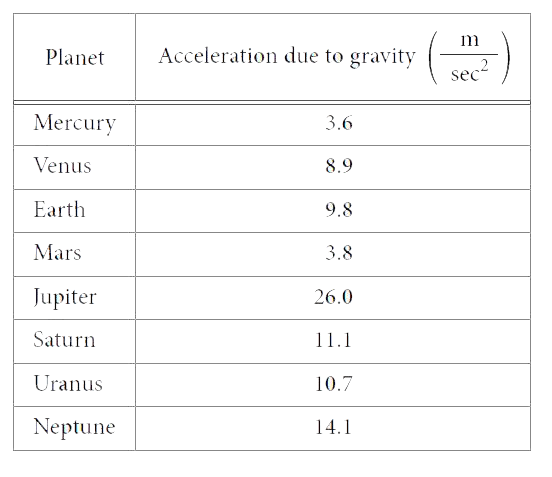The weight of an object lies at the ............
Centre of mass
Centre of buoyancy
Centre of gravity
Geometric centre always
The correct Answer is:C
Definition of centre of gravity
Similar Questions
The weight of an object is 90 kg at the surface of the earth. If it is taken to a height equal to half of the radius of the earth, then its weight will become
View SolutionThe gravitational force exerted by the Earth on an object is called ..................... (weight/mass)
View SolutionThe weight of an object at the centre of the earth of radius R is
View SolutionThe weight of an object on the surface of the Earth is 40 N. Its weight at a height equal to the radius of the Earth is
View Solution
The chart above shows approximate of the acceleration due to gravity in meters per second squared (msec2) for the eight planets in our solar system. The weight of an object on a given planet can be found by using the formula W=mg, where W is the weight of the object measured in newtons, m is the of the object measured in kilograms, and g is the acceleration due to gravity on the planet measured in msec2.
An object on Earth has a weight of 150 newtons. On which planet would the same object have an approximate weight of 170 newtons?View Solution
The chart above shows approximate of the acceleration due to gravity in meters per second squared (msec2) for the eight planets in our solar system. The weight of an object on a given planet can be found by using the formula W=mg, where W is the weight of the object measured in newtons, m is the of the object measured in kilograms, and g is the acceleration due to gravity on the planet measured in msec2.
What is the weight, in newtons, of an object on Mercury with a mass of 90 kilograms?View SolutionThe weight of an object in the coal mine, sea level and at the top of the mountain are W1,W2 and W3 respectively, then
View SolutionWith the increase in the weight of an object, the pressure :
View SolutionIf the diameter of the earth becomes two times its present value and its mass remains unchanged then how would the weight of an object on the surface of the earth be affected ?
View SolutionAssertion: Mass is a property of one object alone, whereas weight results from the interaction of two objects.
Reason: The weight of an object is proportional to its mass.View Solution


